Method for Producing Columnar Ice in Laboratory and Its Application
Abstract
1. Introduction
2. Methods
2.1. Design of Wind Tunnel
2.1.1. Design of Test Section and Settling Chamber
2.1.2. Design of the Contraction
2.1.3. Design of Exit Diffuser and Wide-Angle Diffuser
2.2. Ice Formation Test
2.2.1. Test Devices
2.2.2. Test Procedure
3. Results and Discussion
3.1. Selection of the Wind Tunnel Contraction Section
3.1.1. The Distribution of Pressure and Velocity
3.1.2. Comparison of Dynamic Pressure Coefficient and Velocity Non-Uniformity
3.2. Wind Tunnel Test Section Velocity Verification
3.3. Results and Discussion of Ice Formation Test
3.4. Results and Discussion of Ice Crystal Measurement
3.5. Application Discussion
4. Conclusions
Author Contributions
Funding
Data Availability Statement
Acknowledgments
Conflicts of Interest
References
- Cole, D.M. The microstructure of ice and its influence on mechanical properties. Eng. Fract. Mech. 2001, 68, 1797–1822. [Google Scholar] [CrossRef]
- Timco, G.W.; Weeks, W.F. A review of the engineering properties of sea ice. Cold Reg. Sci. Technol. 2010, 60, 107–129. [Google Scholar] [CrossRef]
- Moline, M.A.; Karnovsky, N.J.; Brown, Z.; Divoky, G.J.; Frazer, T.K.; Jacoby, C.A.; Torres, J.J.; Fraser, W.R. High latitude changes in ice dynamics and their impact on polar marine ecosystems. Ann. N. Y. Acad. Sci. 2008, 1134, 267–319. [Google Scholar] [CrossRef]
- Xu, H.; Yin, Z.; Jia, D.; Jin, F.; Ouyang, H. The potential seasonal alternative of Asia–Europe container service via Northern sea route under the Arctic sea ice retreat. Marit. Pol. Mgmt. 2011, 38, 541–560. [Google Scholar] [CrossRef]
- Goerlandt, F.; Goite, H.; Banda, O.A.V.; Höglund, A.; Rainio, P.A.; Lensu, M. An analysis of wintertime navigational accidents in the Northern Baltic Sea. Saf. Sci. 2017, 92, 66–84. [Google Scholar] [CrossRef]
- Lee, H.W.; Roh, M.; Kim, K.S. Ship route planning in Arctic ocean based on POLARIS. Ocean Eng. 2021, 234, 109297. [Google Scholar] [CrossRef]
- Shu, Y.; Zhu, Y.; Xu, F.; Gan, L.; Lee, P.T.; Yin, J.; Chen, J. Path planning for ships assisted by the icebreaker in ice-covered waters in the Northern Sea Route based on optimal control. Ocean Eng. 2023, 267, 113182. [Google Scholar] [CrossRef]
- Petrovic, J.J. Review mechanical properties of ice and snow. J. Mater. Sci. 2003, 38, 1–6. [Google Scholar] [CrossRef]
- Dempsey, J.P. Research trends in ice mechanics. Int. J. Solids Struct. 2000, 37, 131–153. [Google Scholar] [CrossRef]
- Timco, G.W.; Brien, S.O. Flexural strength equation for sea ice. Cold Reg. Sci. Technol. 1994, 22, 285–298. [Google Scholar] [CrossRef]
- Moslet, P.O. Field testing of uniaxial compression strength of columnar sea ice. Cold Reg. Sci. Technol. 2007, 48, 1–14. [Google Scholar] [CrossRef]
- Li, Z.; Zhang, L.; Lu, P.; Leppäranta, M.; Li, G. Experimental study on the effect of porosity on the uniaxial compressive strength of sea ice in Bohai Sea. Sci. China Technol. Sci. 2011, 54, 2429–2436. [Google Scholar] [CrossRef]
- Bonath, V.; Edeskär, T.; Lintzén, N.; Fransson, L.; Cwirzen, A. Properties of ice from first-year ridges in the Barents Sea and Fram Strait. Cold Reg. Sci. Technol. 2019, 168, 102890. [Google Scholar] [CrossRef]
- Menge, J.A.R.; Jones, K.F. The tensile strength of first-year sea ice. J. Glaciol. 1993, 39, 609–618. [Google Scholar] [CrossRef]
- Han, H.; Jia, Q.; Huang, W.; Li, Z. Flexural strength and effective modulus of large columnar-grained freshwater ice. J. Cold Reg. Eng. 2016, 30, 04015005. [Google Scholar] [CrossRef]
- Karulina, M.; Marchenko, A.; Karulin, E.; Sodhi, D.; Sakharov, A.; Chistyakov, P. Full-scale flexural strength of sea ice and freshwater ice in Spitsbergen Fjords and North-West Barents Sea. Appl. Ocean Res. 2019, 90, 101853. [Google Scholar] [CrossRef]
- Alekseeva, T.A.; Frolov, S.V.; Serovetnikov, S.S. Review of methods and main results of sea ice thickness measurements in the Arctic. Russ. Arctic. 2021, 1, 33–49. (In Russian) [Google Scholar] [CrossRef]
- Worby, A.P.; Griffin, P.W.; Lytle, V.I.; Massom, R.A. On the use of electromagnetic induction sounding to determine winter and spring sea ice thickness in the Antarctic. Cold Reg. Sci. Technol. 1999, 29, 49–58. [Google Scholar] [CrossRef]
- Uto, S.; Toyota, T.; Shimoda, H.; Takeyama, K.; Shirasawa, K. Ship-borne electromagnetic induction Sounding of Sea-ice thickness in the Southern Sea of Okhotsk. Ann. Glaciol. 2006, 44, 253–260. [Google Scholar] [CrossRef]
- McLaren, A.S. The under-ice thickness distribution of the Arctic Basin as recorded in 1958 and 1970. J. Geophys. Res.-Ocean. 1989, 94, 4971–4983. [Google Scholar] [CrossRef]
- Vinje, T.; Nordlund, N.; Kvambekk, Å. Monitoring ice thickness in Fram Strait. J. Geophys. Res.-Ocean. 1998, 103, 10437–10449. [Google Scholar] [CrossRef]
- Giles, K.A.; Laxon, S.W.; Ridout, A.L. Circumpolar thinning of Arctic sea ice following the 2007 record ice extent minimum. Geophys. Res. Lett. 2008, 35, L22502. [Google Scholar] [CrossRef]
- Griggs, J.A.; Bamber, J.L. Antarctic ice-shelf thickness from satellite radar altimetry. J. Glaciol. 2011, 57, 485–498. [Google Scholar] [CrossRef]
- Fu, H.; Liu, Z.; Guo, X.; Cui, H. Double-frequency ground penetrating radar for measurement of ice thickness and water depth in rivers and canals: Development, verification and application. Cold Reg. Sci. Technol. 2018, 154, 85–94. [Google Scholar] [CrossRef]
- Kwok, R.; Cunningham, G.F. ICESat over Arctic sea ice: Estimation of snow depth and ice thickness. J. Geophys. Res.-Ocean. 2008, 113, 179–185. [Google Scholar] [CrossRef]
- Cole, D.M. Preparation of polycrystalline ice specimens for laboratory experiments. Cold Reg. Sci. Technol. 1979, 1, 153–159. [Google Scholar] [CrossRef]
- Deng, K.; Feng, X.; Tian, X.; Hu, Y. Experimental research on compressive mechanical properties of ice under low strain rates. Mater. Today Commun. 2020, 24, 101029. [Google Scholar] [CrossRef]
- Zhang, Y.; Qian, Z.; Lv, S.; Huang, W.; Ren, J.; Fang, Z.; Chen, X. Experimental investigation of uniaxial compressive strength of distilled water ice at different growth temperatures. Water 2022, 14, 4079. [Google Scholar] [CrossRef]
- Ghobrial, T.R.; Loewen, M.R.; Hicks, F. Laboratory calibration of upward looking sonars for measuring suspended frazil ice concentration. Cold Reg. Sci. Technol. 2012, 70, 19–31. [Google Scholar] [CrossRef]
- Roscoe, H.K.; Brooks, B.; Jackson, A.V.; Smith, M.H.; Walker, S.J.; Obbard, R.W.; Wolff, E.W. Frost flowers in the laboratory: Growth, characteristics, aerosol, and the underlying sea ice. J. Geophys. Res. Atmos. 2011, 116, D12301. [Google Scholar] [CrossRef]
- Haas, C. Ice tank investigations of the microstructure of artificial sea ice grown under different boundary conditions during INTERICE II. In Proceedings of the HYDRALAB Workshop, Hannover, Germany, 19 February 1999. [Google Scholar]
- Weeks, W.F. Tensile strength of NaCl ice. J. Glaciol. 1962, 4, 25–52. [Google Scholar] [CrossRef][Green Version]
- Cottier, F.; Eicken, H.; Wadhams, P. Linkages between salinity and brine channel distribution in young sea ice. J. Geophys. Res.-Ocean. 1999, 104, 15859–15871. [Google Scholar] [CrossRef]
- Loose, B.; McGillis, W.R.; Schlosser, P.; Perovich, D.; Takahashi, T. Effects of freezing, growth, and ice cover on gas transport processes in laboratory seawater experiments. Geophys. Res. Lett. 2009, 36, 1–5. [Google Scholar] [CrossRef]
- Perovich, D.K.; Grenfell, T.C. Laboratory studies of the optical properties of young sea ice. J. Glaciol. 1981, 27, 331–346. [Google Scholar] [CrossRef]
- Marks, A.A.; Lamare, M.L.; King, M.D. Optical properties of laboratory grown sea ice doped with light absorbing impurities (black carbon). Cryosphere 2017, 11, 2867–2881. [Google Scholar] [CrossRef]
- Liu, R.; Liu, Y.; Wang, Q.; Yi, X. Investigation of microstructure and density of atmospheric ice formed by high-wind-speed in-cloud icing. Crystals 2023, 13, 1015. [Google Scholar] [CrossRef]
- Bansmer, S.E.; Baumert, A.; Sattler, S.; Knop, I.; Leroy, D.; Schwarzenboeck, A.; Jurkat-Witschas, T.; Voigt, C.; Pervier, H.; Esposito, B. Design, construction and commissioning of the Braunschweig Icing Wind Tunnel. Atmos. Meas. Tech. 2018, 11, 3221–3249. [Google Scholar] [CrossRef]
- Blocken, B.; Stathopoulos, T.; Van Beeck, J.P.A.J. Pedestrian-level wind conditions around buildings: Review of wind-tunnel and CFD techniques and their accuracy for wind comfort assessment. Build. Environ. 2016, 100, 50–81. [Google Scholar] [CrossRef]
- Mehta, R.D.; Bradshaw, P. Design rules for small low speed wind tunnels. Aeronaut. J. 1979, 83, 443–453. [Google Scholar] [CrossRef]
- Zanoun, E.S. Flow characteristics in low-speed wind tunnel contractions: Simulation and testing. Alex. Eng. J. 2018, 57, 2265–2277. [Google Scholar] [CrossRef]
- Zhang, Y.; Qian, Z.; Huang, W.; Chen, X.; Zhang, Z.; Ren, J. Effect of grain size on the uniaxial compressive strength of ice forming with different wind speeds in a cold laboratory. Water 2024, 16, 2049. [Google Scholar] [CrossRef]
- Morel, T. Design of Two-Dimensional Wind Tunnel Contractions. J. Fluids Eng. 1977, 99, 371–377. [Google Scholar] [CrossRef]
- Schulson, E.M. The brittle compressive fracture of ice. Acta Metall. Mater. 1990, 38, 1963–1976. [Google Scholar] [CrossRef]
- Cole, D.M. Strain-rate and Grain-size Effects in Ice. J. Glaciol. 1987, 33, 274–280. [Google Scholar] [CrossRef]
- Nixon, W.A. Wing crack models of the brittle compressive failure of ice. Cold Reg. Sci. Technol. 1996, 24, 41–55. [Google Scholar] [CrossRef]
- Zhang, Y.; Zhang, Y.; Guo, R.; Cui, B. Method for testing shear and tensile strengths of freshwater/seawater ice. Water 2022, 14, 1363. [Google Scholar] [CrossRef]
- Wang, Q.; Li, Z.; Lu, P.; Xu, Y.; Li, Z. Flexural and compressive strength of the landfast sea ice in the Prydz Bay, East Antarctic. Cryosphere 2022, 16, 1941–1961. [Google Scholar] [CrossRef]
- Ji, S.; Chen, X.; Wang, A. Influence of the loading direction on the uniaxial compressive strength of sea ice based on field measurements. Ann. Glaciol. 2020, 61, 86–96. [Google Scholar] [CrossRef]
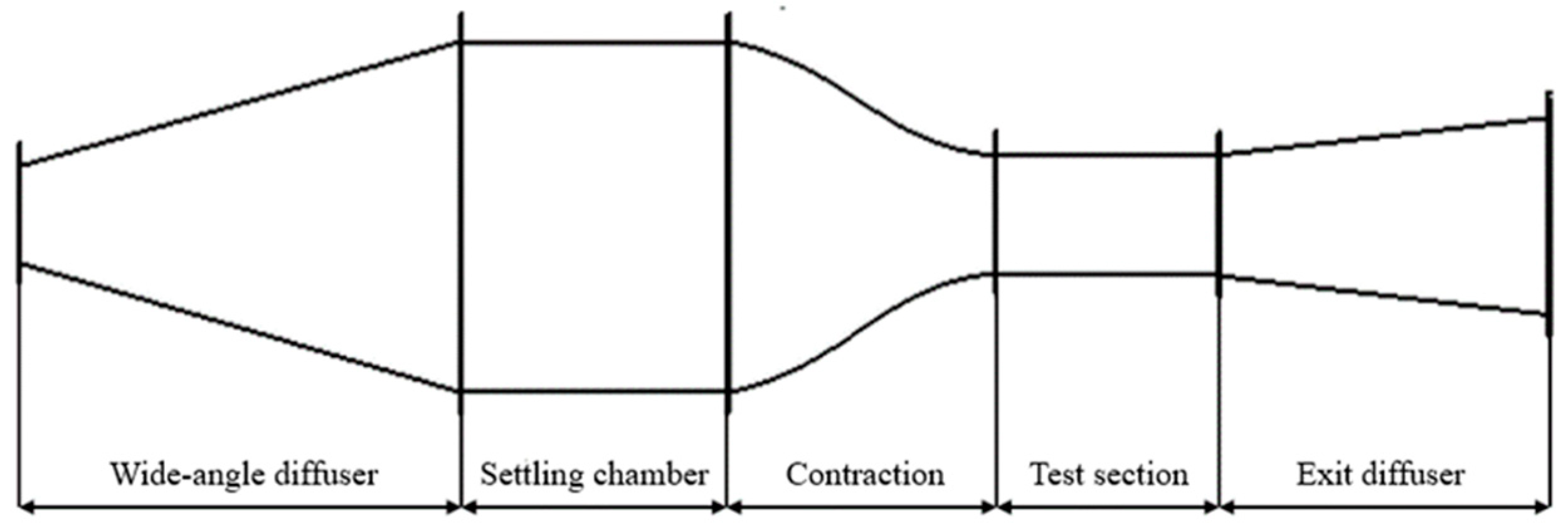
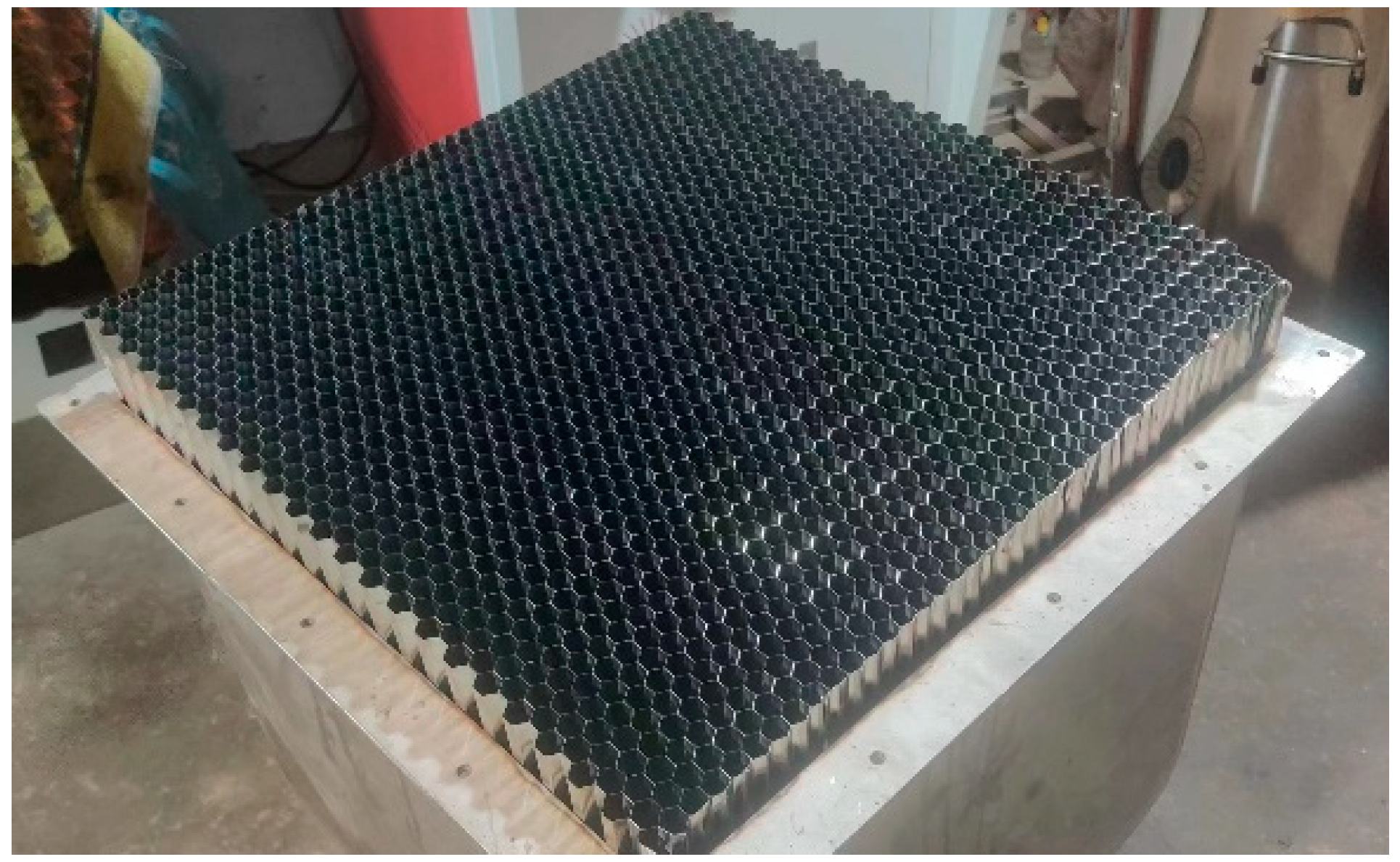
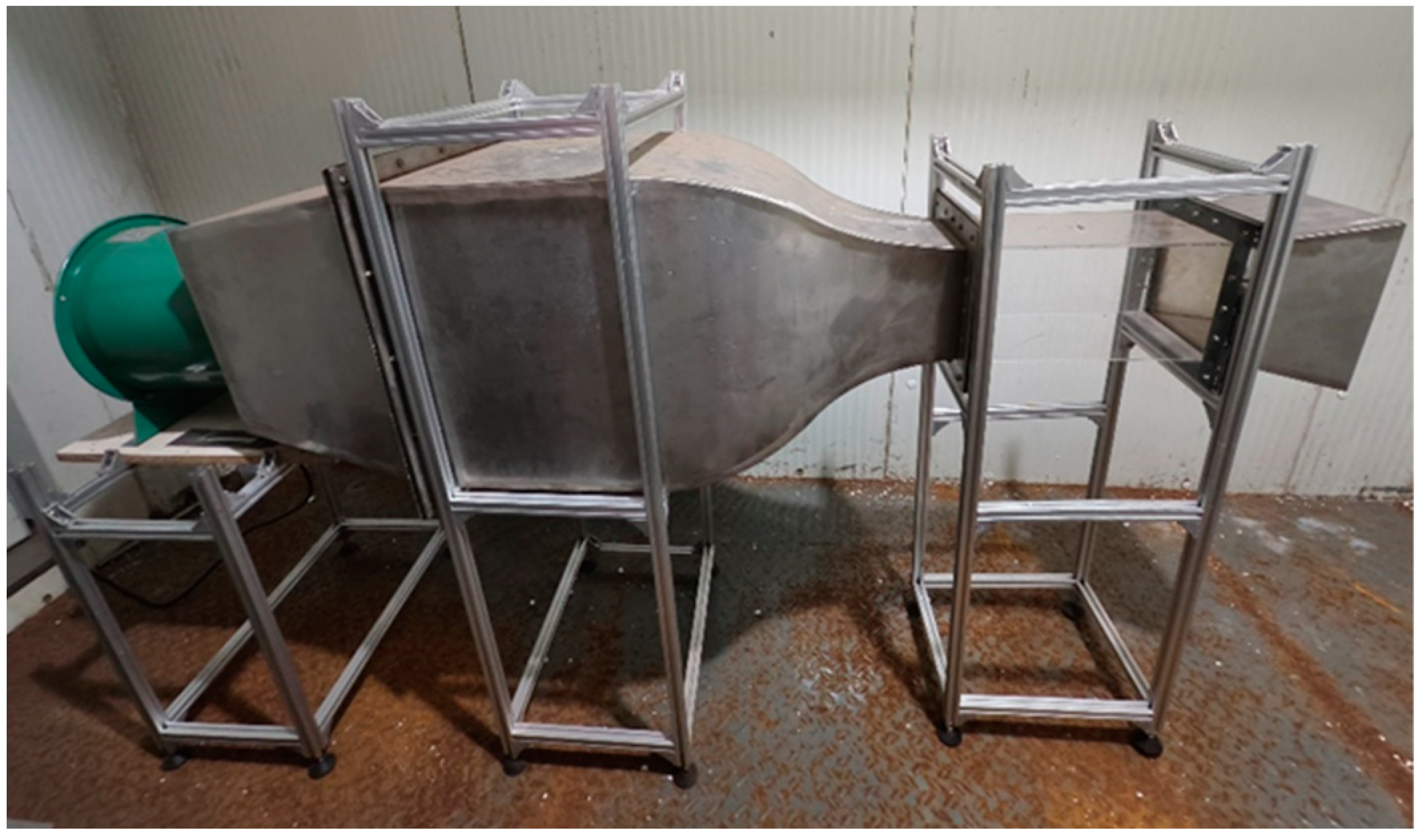
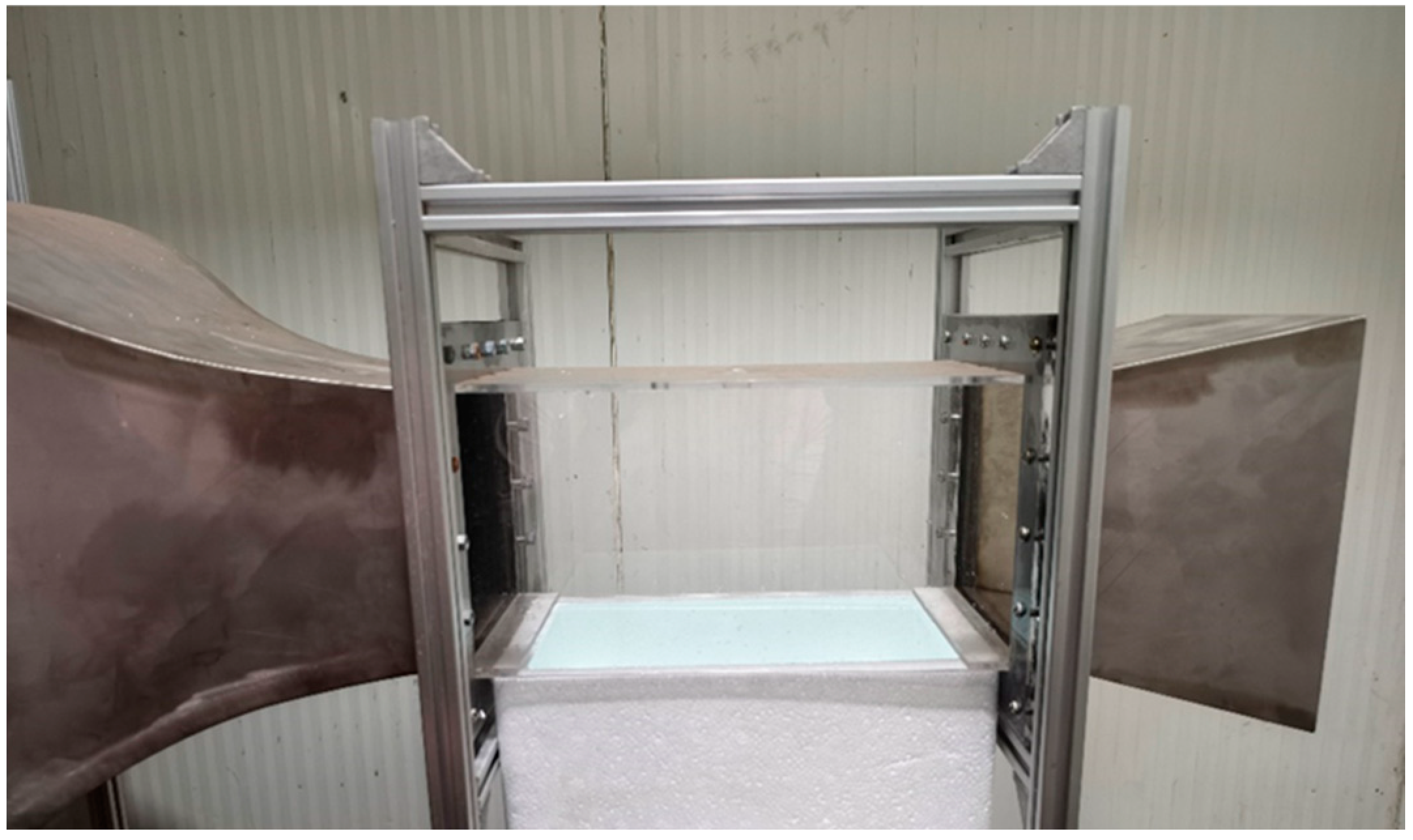
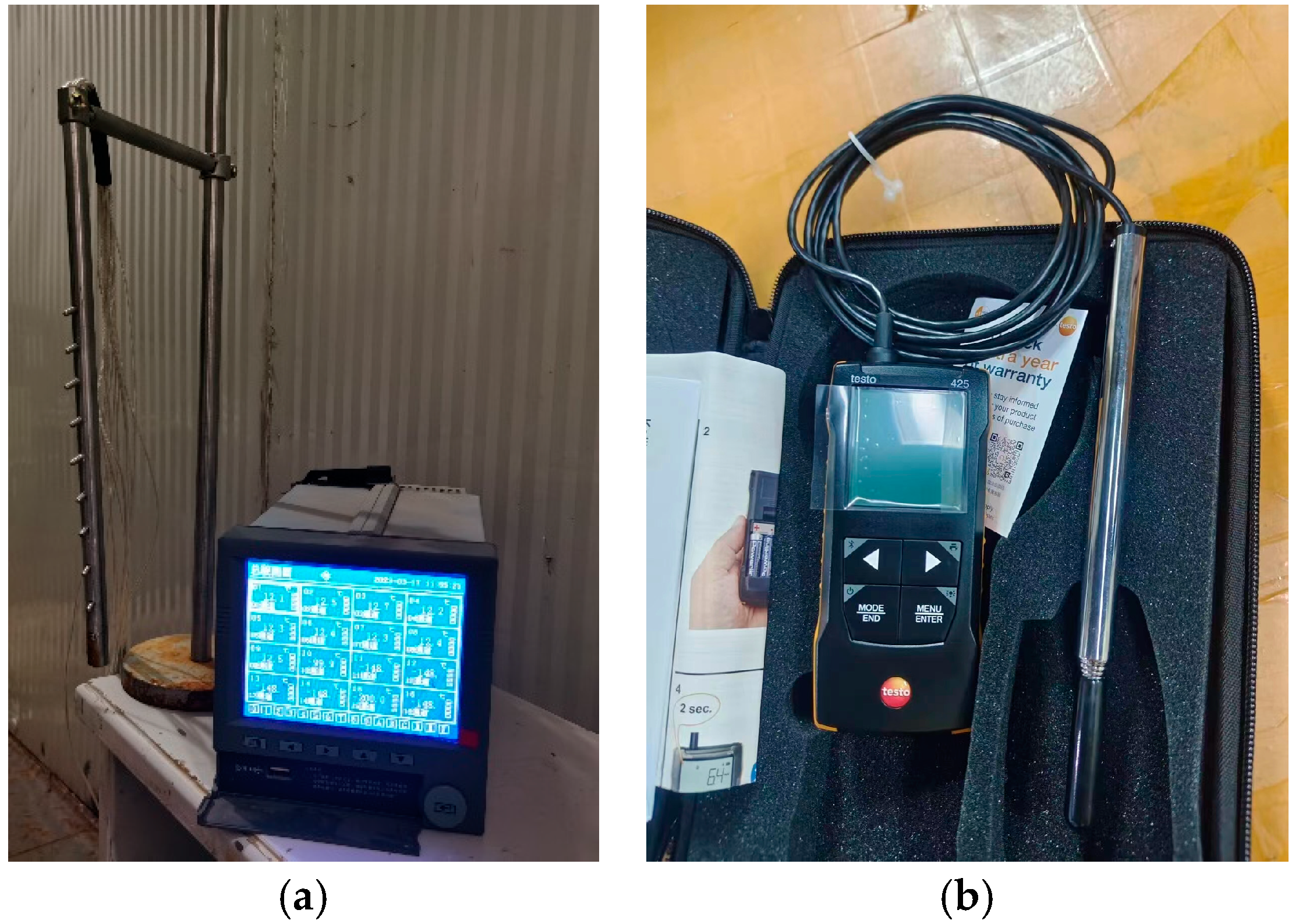
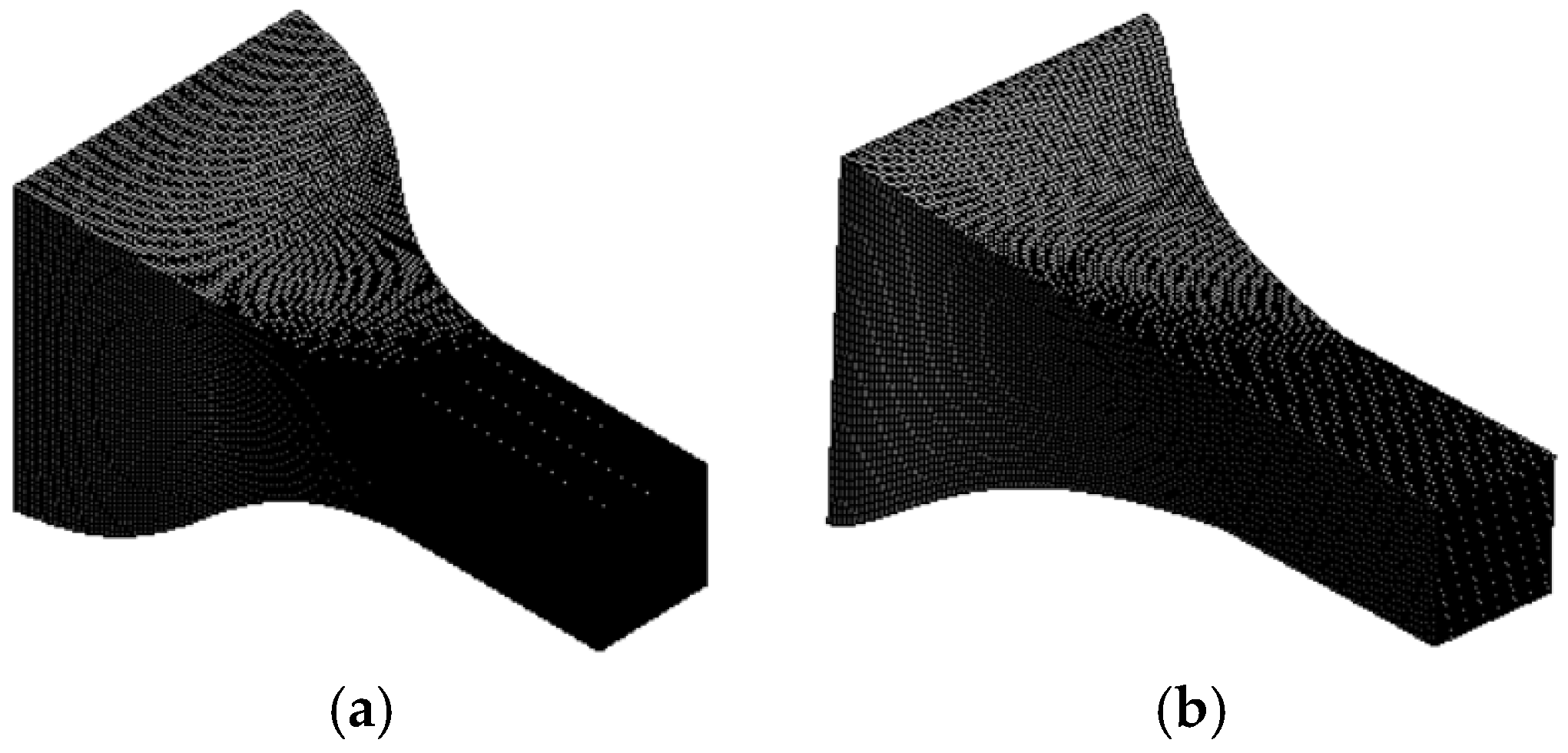
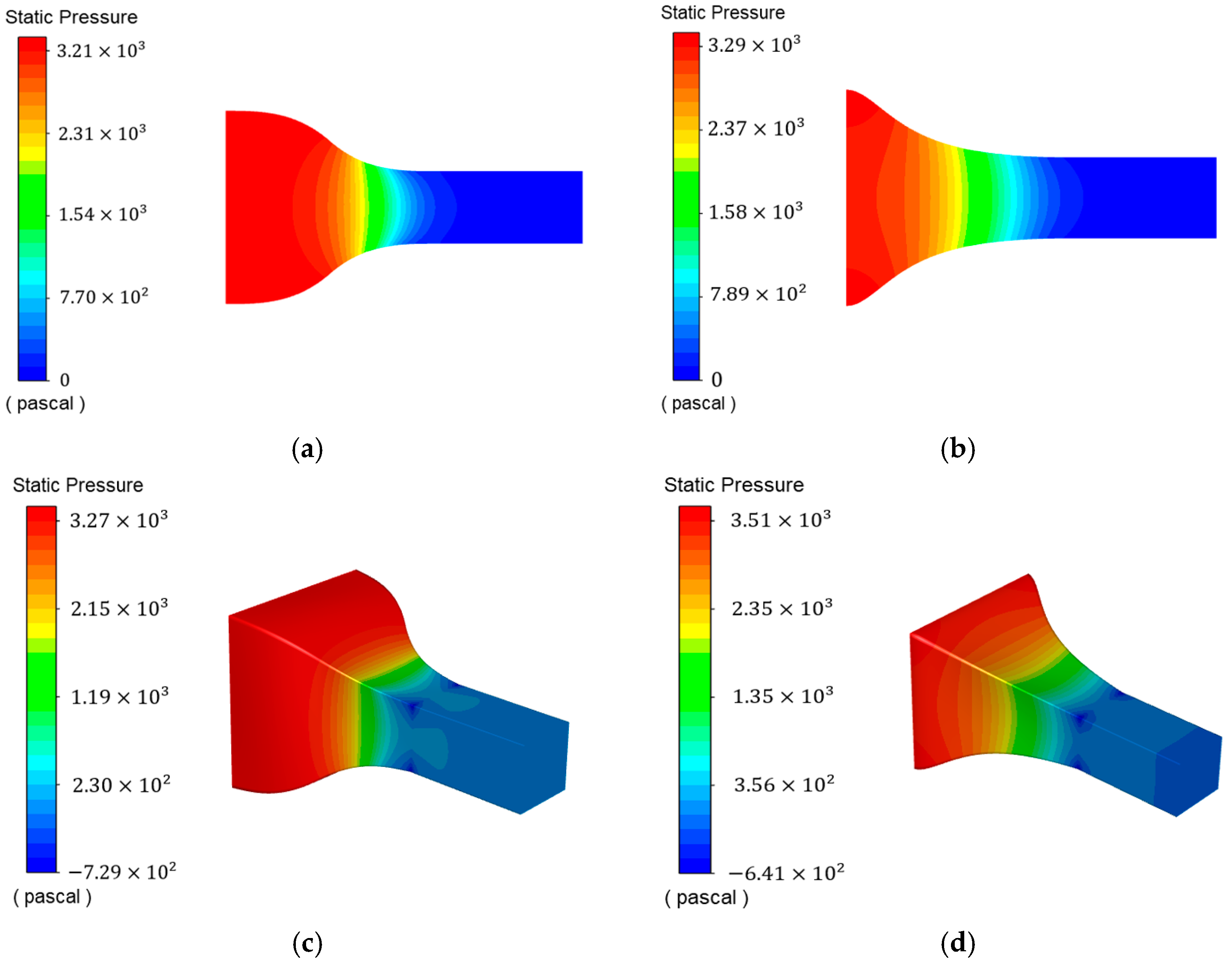
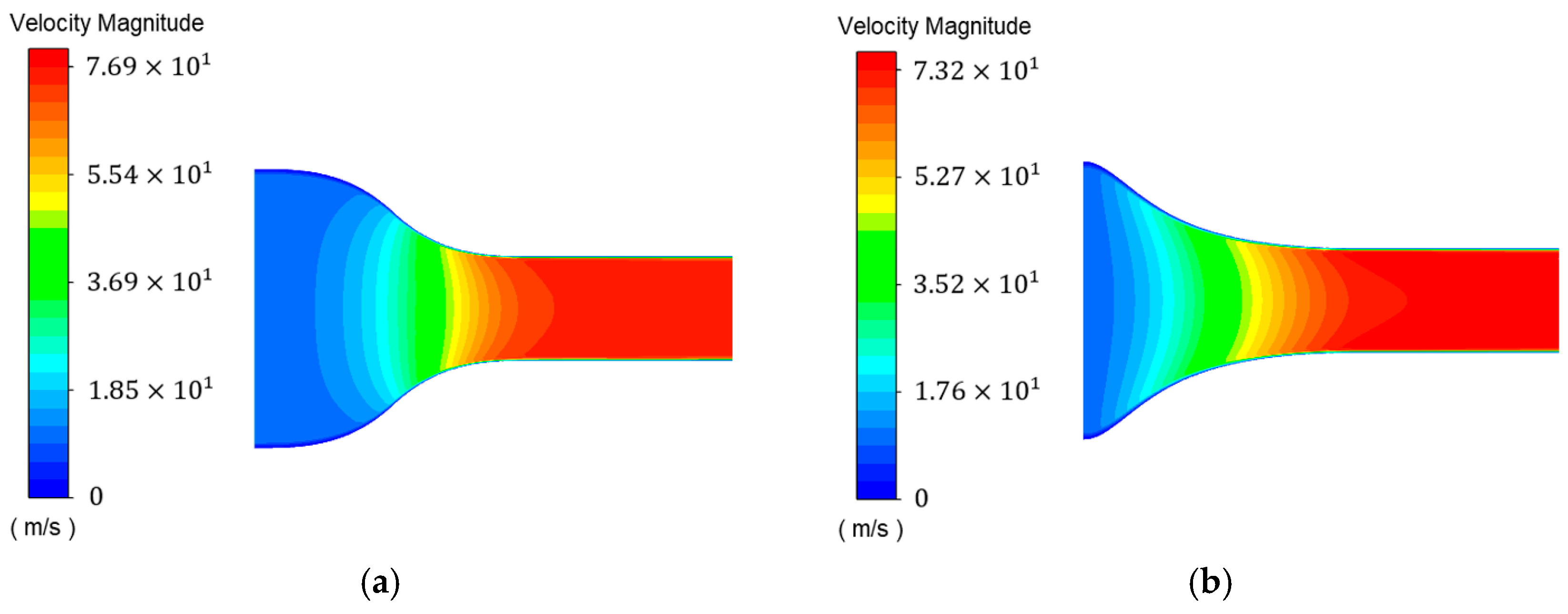
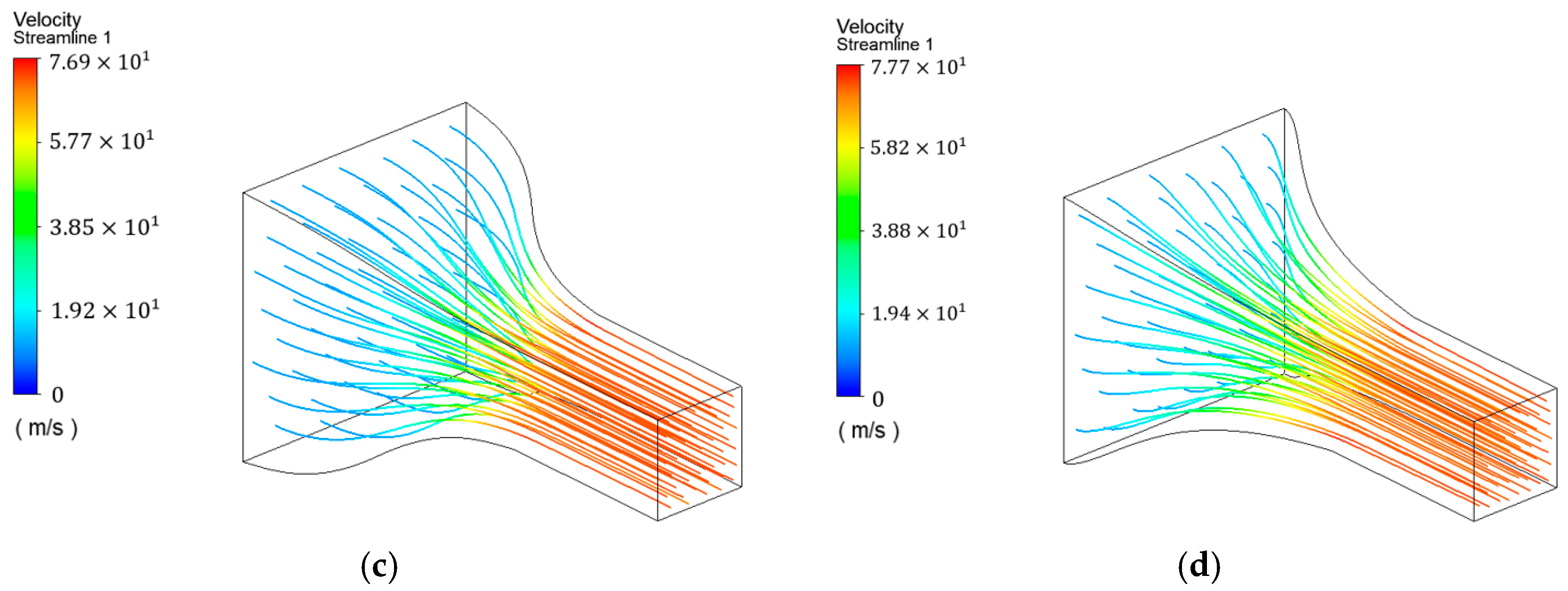
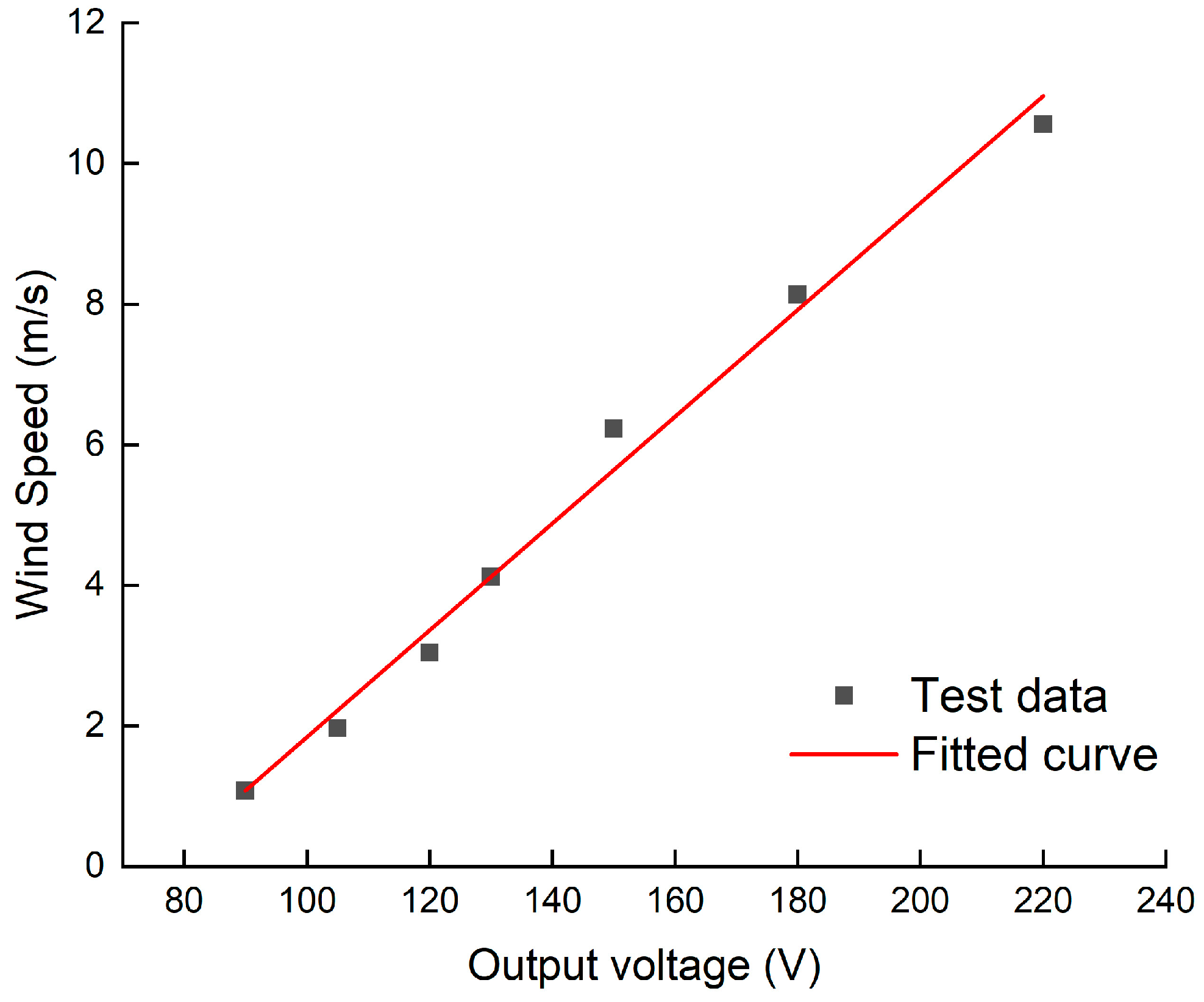



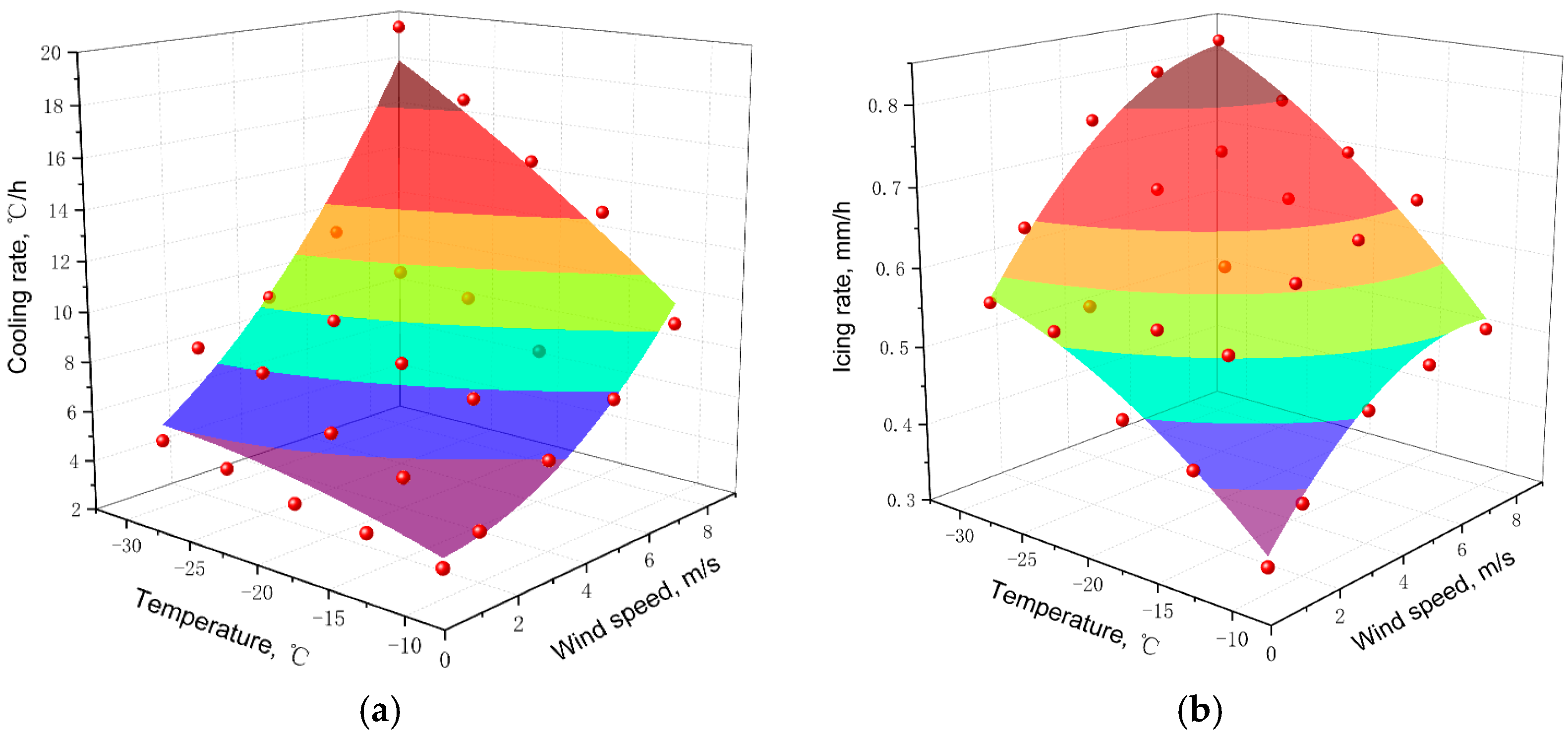
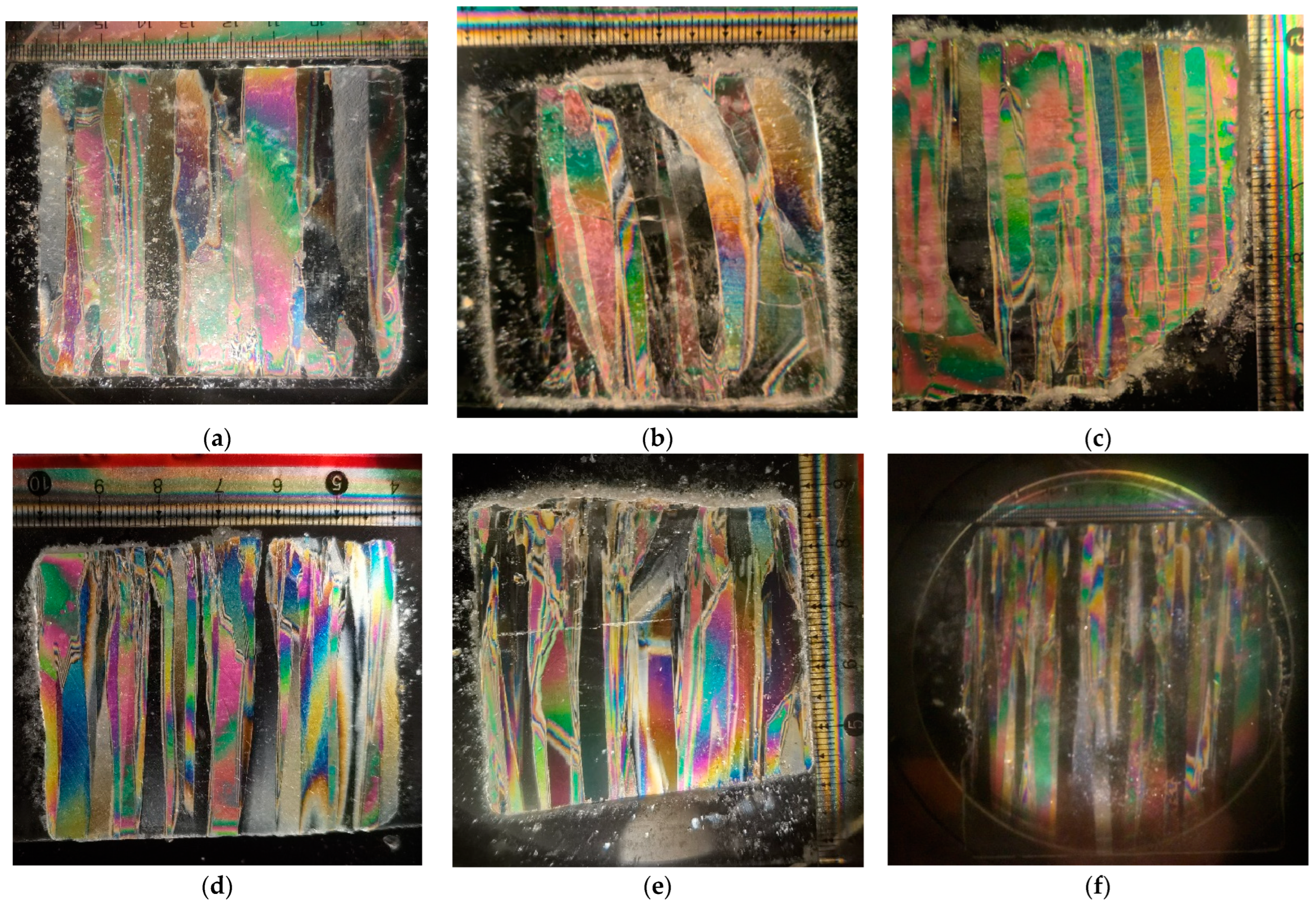
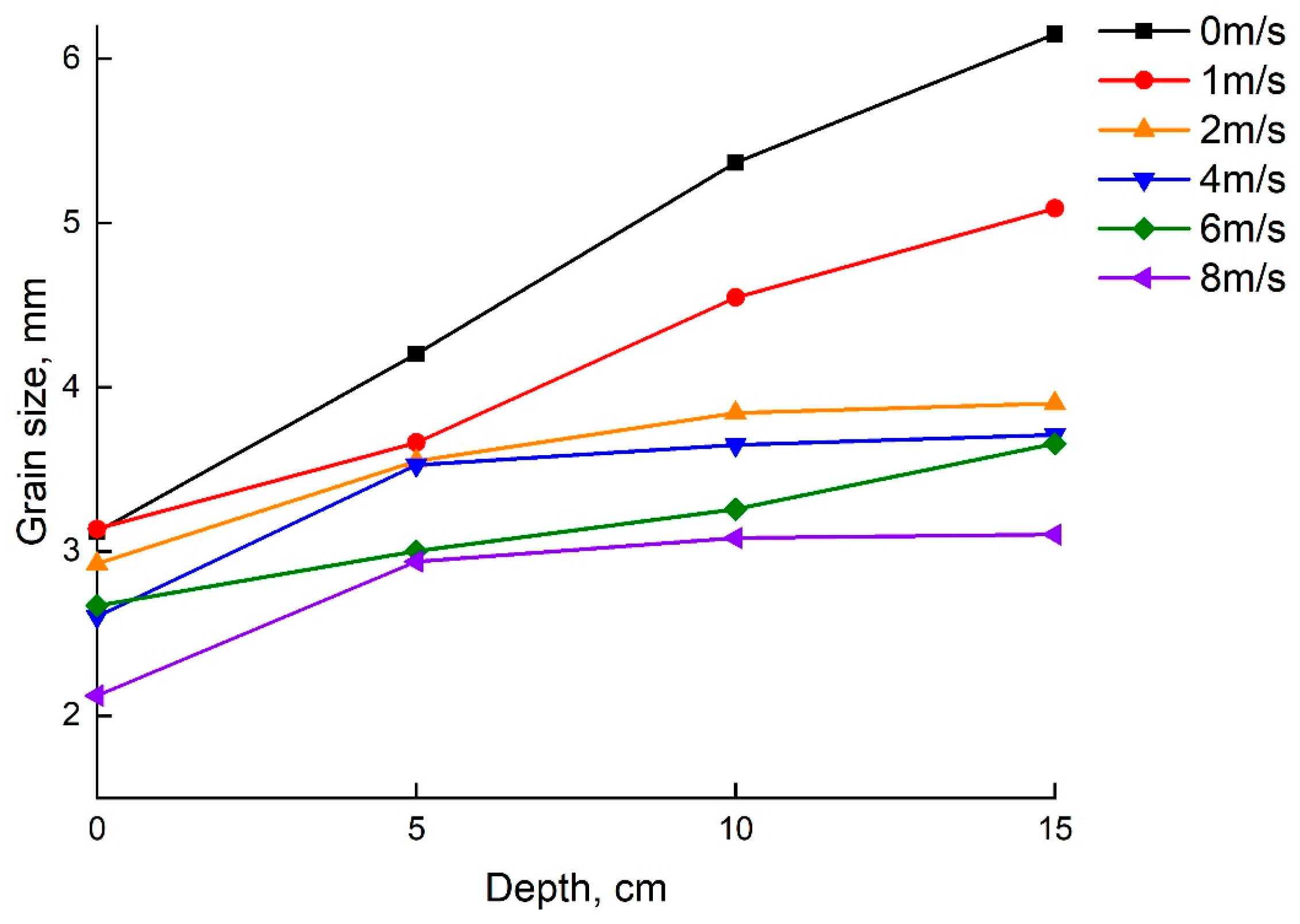
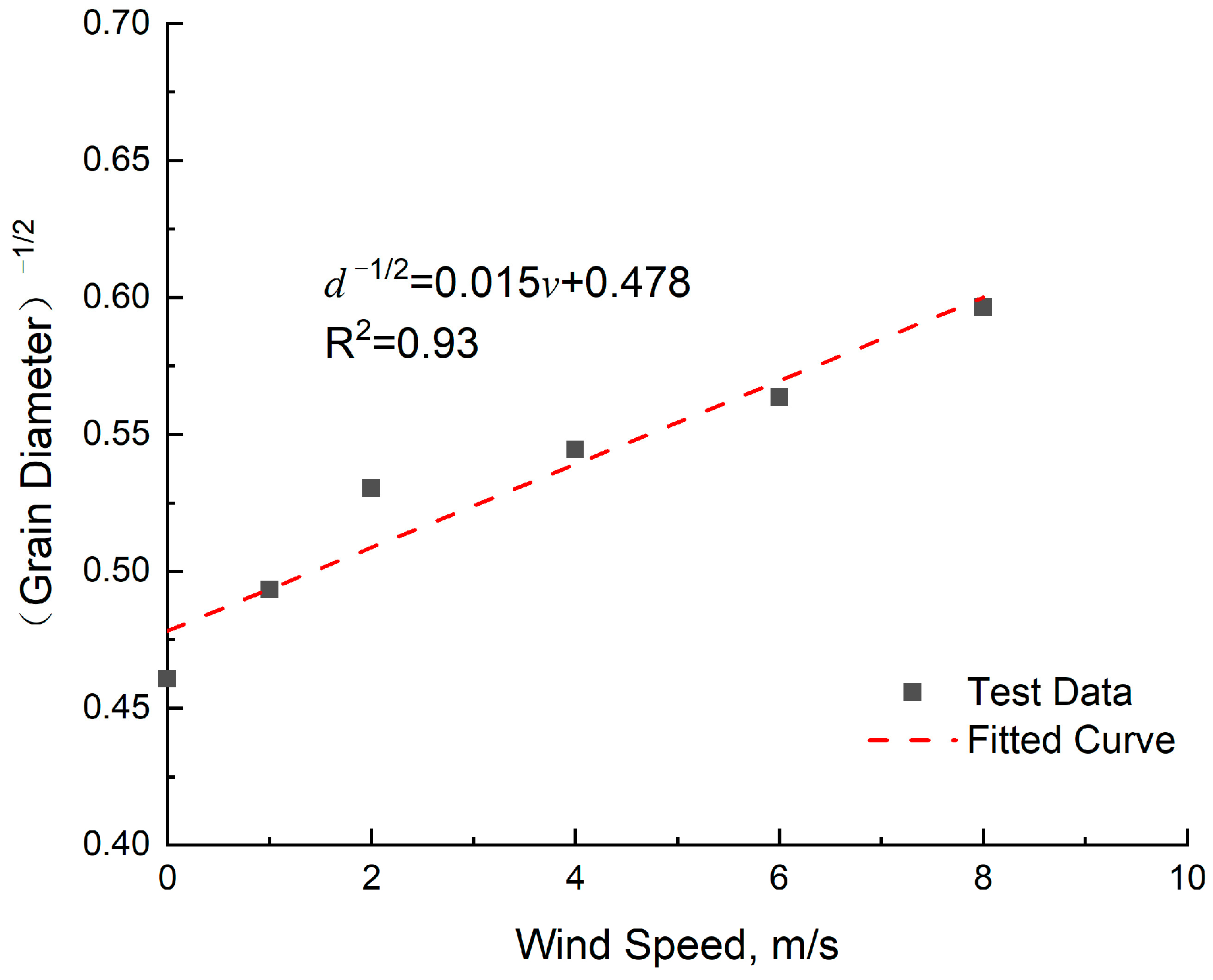
| Wind Speed (m/s) | 0.1 | 1 | 3 | 10 |
|---|---|---|---|---|
| Two cubic arcs | 0.071 | 0.025 | 0.022 | 0.019 |
| Witosznski curve | 0.061 | 0.046 | 0.036 | 0.032 |
| Wind Speed (m/s) | 0.1 | 1 | 3 | 10 |
|---|---|---|---|---|
| Two cubic arcs | 0.035 | 0.012 | 0.011 | 0.009 |
| Witosznski curve | 0.030 | 0.023 | 0.018 | 0.016 |
| Output Voltages (V) | Average Wind Speed at the Midpoint of the Test Section (m/s) | Average Wind Speed at the Contraction Section Entrance (m/s) | Speed Ratio |
|---|---|---|---|
| 90 | 1.08 | 0.16 | 6.75 |
| 105 | 1.97 | 0.29 | 6.79 |
| 120 | 3.04 | 0.45 | 6.76 |
| 130 | 4.12 | 0.61 | 6.75 |
| 150 | 6.23 | 0.92 | 6.77 |
| 180 | 8.13 | 1.21 | 6.72 |
| 220 | 10.56 | 1.57 | 6.73 |
| Wind Speed/Temperature | −10 °C | −15 °C | −20 °C | −25 °C | −30 °C |
|---|---|---|---|---|---|
| 1 m/s | 3.15 | 3.56 | 3.81 | 4.37 | 4.71 |
| 2 m/s | 3.94 | 5.13 | 6.06 | 7.72 | 8.05 |
| 4 m/s | 5.56 | 7.20 | 7.91 | 8.98 | 9.35 |
| 6 m/s | 6.97 | 8.20 | 9.73 | 10.23 | 11.40 |
| 8 m/s | 9.13 | 13.09 | 14.71 | 16.88 | 19.63 |
| Wind Speed/Temperature | −10 °C | −15 °C | −20 °C | −25 °C | −30 °C |
|---|---|---|---|---|---|
| 1 m/s | 3.31 | 4.19 | 4.54 | 5.39 | 5.54 |
| 2 m/s | 3.88 | 5.41 | 5.49 | 5.57 | 6.36 |
| 4 m/s | 4.67 | 6.00 | 6.01 | 6.80 | 7.53 |
| 6 m/s | 4.92 | 6.29 | 6.63 | 7.08 | 7.99 |
| 8 m/s | 5.09 | 6.57 | 7.03 | 7.57 | 8.26 |
Disclaimer/Publisher’s Note: The statements, opinions and data contained in all publications are solely those of the individual author(s) and contributor(s) and not of MDPI and/or the editor(s). MDPI and/or the editor(s) disclaim responsibility for any injury to people or property resulting from any ideas, methods, instructions or products referred to in the content. |
© 2024 by the authors. Licensee MDPI, Basel, Switzerland. This article is an open access article distributed under the terms and conditions of the Creative Commons Attribution (CC BY) license (https://creativecommons.org/licenses/by/4.0/).
Share and Cite
Zhang, Y.; Qian, Z.; Huang, W. Method for Producing Columnar Ice in Laboratory and Its Application. Water 2024, 16, 2558. https://doi.org/10.3390/w16182558
Zhang Y, Qian Z, Huang W. Method for Producing Columnar Ice in Laboratory and Its Application. Water. 2024; 16(18):2558. https://doi.org/10.3390/w16182558
Chicago/Turabian StyleZhang, Yujia, Zuoqin Qian, and Weilong Huang. 2024. "Method for Producing Columnar Ice in Laboratory and Its Application" Water 16, no. 18: 2558. https://doi.org/10.3390/w16182558
APA StyleZhang, Y., Qian, Z., & Huang, W. (2024). Method for Producing Columnar Ice in Laboratory and Its Application. Water, 16(18), 2558. https://doi.org/10.3390/w16182558









